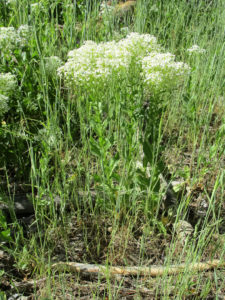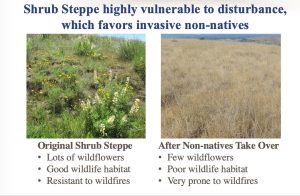What is a weed? As commonly used, “weed” is not really a botanical term, but instead usually means a plant growing where it is not wanted (in other words, a subjective judgement). “Weed” is also often part of the name of a plant (e.g., chickweed, tarweed, gumweed) that is particularly common, independent of any other attributes of that plant. Other terms are therefore usually used in reference to wild plants; i.e., native, non-native, established/naturalized, and invasive.

What makes a plant native vs. non-native? At least in North America, native plants are those that were already present in an area prior to the post-Columbian Interchange that began in the late 15th Century (as well described in Mann’s book “1493″). Non-native plants are those whose current distribution results from the activities of explorers, merchants, settlers, and others from the Eastern Hemisphere. For the most part this involves plants from Eurasia, but it also applies to plants from one part of North America that have been relocated with human assistance to other parts of North America where they did not previously occur. A non-native plant that has developed self-sustaining populations outside of cultivation in areas beyond its pre-Columbian native range is referred to as established or naturalized.
Why does this matter? For a start, the unique suite of native plants growing in a particular place (e.g., the Boise Front) are what makes that area special, often including endemic species that grow no where else, or at least unique genotypes. In contrast, non-natives are generally widespread “lowest common denominators”; i.e., plants that are found in similar areas throughout the world. As a result, the well-being of native plants can be critical to global biodiversity, while non-natives are of minimal significance in this regard (though admittedly better than lawn!)
In addition, and as well summarized by Douglas Tallamy (e.g., Nature’s Best Hope, 2019), plant and animal species usually co-evolve over thousands of years, resulting in relatively harmonious and stable ecological communities consisting of numerous species engaged in a highly complex network of biological interactions. New species that are suddenly added to the mix rarely add much in the way of benefit to the community, at least compared to the co-evolved natives, and can often be extremely detrimental.

What are invasive species? Although the majority of non-native species have limited ecological impact, and in rare cases can even provide some benefits, there are some that are so aggressive in their new home that they essentially crowd out most other plants and even destroy the habitat needed by the natives. These hyper-competitors are often called invasive species, and when they take over they can reduce both local and global biodiversity by threatening not only most native plant species, but all the insect and other animal species that are dependent on that plant in a complex web of ecological interactions. Cheatgrass and white-top are well-known examples, but there are unfortunately many others.
As a result, although the initial appearance of non-natives can appear to be a desirable increase in local biodiversity, especially if the non-natives have showy flowers (like bachelor’s-buttons, Centaurea cyanus), the long-term result is usually a net LOSS in local biodiversity, primarily of the unique native species that made the local area special. As these locally unique species decline and are replaced with widespread non-native species that are common elsewhere, global biodiversity also declines.
The shrub-steppe ecosystem that was a dominant component of the interior West is highly vulnerable to transformation by invasive species, resulting in a degraded ecosystem that supports drastically fewer native plants species and the animals that co-evolved with them, and that also provides fewer of the ecosystem services that human societies depend on. Reversal of a degraded ecosystem that has been transformed by invasive species can be extremely difficult, if not impossible.
Legal Definitions: For official purposes, especially where land management is involved, various government levels and agencies have specific lists and/or definitions. For example:
Idaho Noxious Weeds: see https://invasivespecies.idaho.gov/plants
Bureau of Land Management (from Noxious Weed and Invasive Plant Management environmental assessment ): “An invasive species is defined as a species that is 1) non-native (or alien) to the ecosystem under consideration, and 2) whose introduction causes or is likely to cause economic or environmental harm or harm to human health (Executive Order 13112). Noxious weeds are invasive species that have been designated “noxious” by state law (Idaho Statute 22).”


